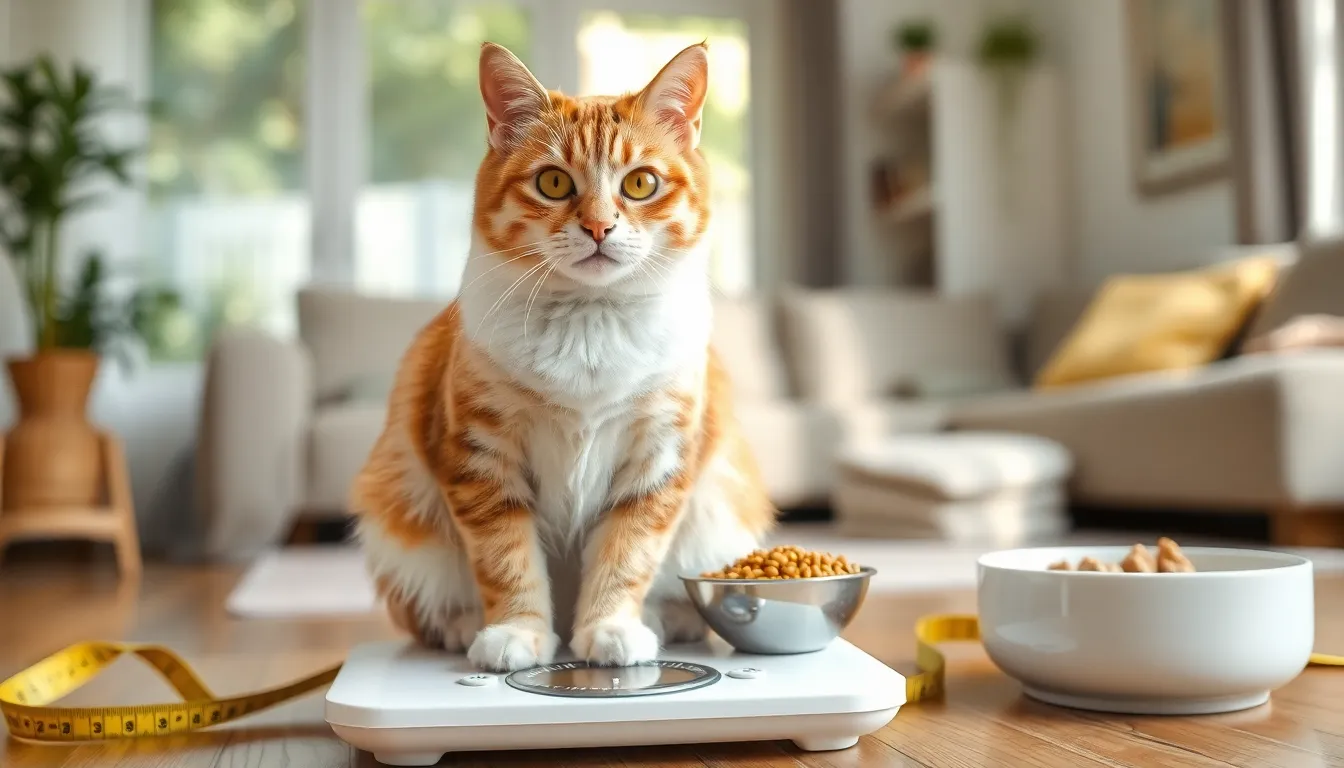Every cat owner knows the struggle: one minute, Fluffy’s a sleek, agile hunter, and the next, she’s a fluffy potato lounging on the couch. Understanding how many calories a cat needs per day based on their weight can be the secret weapon in the battle against kitty fluffiness.
Understanding Cat Caloric Needs
Understanding a cat’s caloric needs plays a vital role in maintaining their health. Accurate caloric intake helps prevent obesity and promotes overall wellbeing.
Importance of Caloric Intake
Caloric intake directly influences a cat’s energy levels. An appropriate amount of calories supports daily activities and functions. Overfeeding often leads to weight gain; weight gain increases the risk of health issues. Conversely, underfeeding may cause malnutrition, lethargy, and weakened immune function. Owners must regularly assess their cat’s weight and adjust caloric intake as needed, ensuring that energy needs align with their lifestyle and health.
Factors Influencing Caloric Needs
Several factors affect a cat’s caloric needs, including age, weight, and activity level. Younger cats typically require more calories due to higher energy requirements for growth. Similarly, active cats burn more calories than sedentary ones; certain breeds may also have different energy needs. Health conditions such as diabetes or thyroid issues can alter caloric requirements as well. Regular veterinary consultations can help determine the precise caloric needs based on these factors.
Calculating Daily Caloric Requirements

Understanding a cat’s daily caloric requirements is essential for maintaining optimal health. This knowledge helps in preventing obesity and ensuring overall wellbeing.
The Role of Weight in Caloric Needs
Weight plays a significant role in determining a cat’s caloric needs. A heavier cat requires more calories to maintain its weight than a lighter cat. Daily caloric intake correlates with body weight, as higher weight leads to increased energy expenditure. For example, a 4 kg (about 8.8 lbs) cat typically requires around 200 to 250 calories daily, while an 8 kg (about 17.6 lbs) cat might need approximately 400 to 500 calories. Regular assessment of a cat’s weight helps adjust caloric intake appropriately, preventing both underfeeding and overfeeding. Moreover, age, health conditions, and activity levels further influence these needs.
Using the Formula for Daily Caloric Intake
Calculating daily caloric intake involves a straightforward formula. The Basal Metabolic Rate (BMR) serves as the foundation. BMR equals 70 multiplied by the cat’s weight in kilograms raised to the power of 0.75. This calculation provides a baseline caloric requirement. After determining BMR, owners should multiply the result by an activity factor ranging from 1.2 for sedentary cats to 1.8 for highly active cats. For instance, an 8 kg (about 17.6 lbs) cat with moderate activity may need approximately 500 calories. Regular updates to caloric needs through a vet help adapt to changes in weight or lifestyle.
Adjusting Caloric Intake for Lifestyle
Different activity levels in cats demand tailored caloric intake to maintain optimal health.
Active Cats vs. Sedentary Cats
Active cats exhibit playful and dynamic behaviors. These cats require 20% to 50% more calories than their sedentary counterparts. Energy-boosting activities, like running and playing, influence their daily caloric needs significantly. For instance, a 5 kg active cat may need approximately 300 to 400 calories daily, while a similar sedentary cat needs about 200 to 250 calories. Ensuring an appropriate caloric intake aligns with their lifestyle prevents weight gain in active cats and malnourishment in less active ones. Monitoring their energy levels can guide owners in adjusting servings.
Special Considerations for Kittens and Seniors
Kittens and senior cats present unique challenges in caloric management. Kittens need more calories, approximately 150% to 200% of adult requirements, due to growth and development. A healthy 1 kg kitten may need around 200 to 250 calories per day. In contrast, senior cats often experience a decrease in metabolism. This decline typically necessitates a reduced caloric intake to prevent obesity, with many needing 20% less than younger adults. Regular veterinarian consultations help owners tailor diets according to age-related needs, ensuring optimal energy levels and overall health.
Common Misconceptions About Cat Calories
Understanding caloric needs is essential for cat owners. Misconceptions often lead to improper feeding practices, which can adversely affect a cat’s health.
Myths About Overfeeding
Many people believe that cats naturally regulate their food intake. This assumption overlooks the fact that abundant food can encourage overeating. Owners may think feeding cats high-calorie treats doesn’t impact their weight, yet those extra calories accumulate over time. Another myth suggests that free-feeding won’t cause obesity. In reality, leaving food out all day tends to promote excessive eating. Active play can sometimes be used to justify regular feeding of high-calorie foods, but it’s crucial to balance energy intake with energy expenditure to prevent weight gain.
The Truth About Underfeeding
Some owners mistakenly think that restricting food lowers a cat’s risk of obesity. While it may seem reasonable, underfeeding can lead to malnutrition and lethargy instead. Many believe that small portions suffice for maintaining weight, regardless of a cat’s activity level or age. This idea ignores that kittens require more calories for growth while senior cats may need fewer due to reduced metabolism. Underestimating caloric requirements can cause health issues in the long run. Regular check-ins with a veterinarian can help ensure cats receive the right amount of calories tailored to their needs.
Conclusion
Understanding a cat’s caloric needs is essential for maintaining their health and wellbeing. By accurately assessing factors like weight age and activity level owners can create a tailored feeding plan that supports their cat’s lifestyle. Regular veterinary consultations play a crucial role in adjusting dietary needs and preventing issues related to obesity or malnutrition.
With the right approach to caloric intake cat owners can ensure their feline companions remain energetic and healthy. It’s not just about feeding but fostering a balanced lifestyle that promotes longevity and happiness in their pets.

